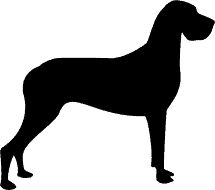Labrador Retriever
Published: Last updated: by Kyle J. Larson
Oh the Labrador Retriever, the most popular dog breed in the world! Energetic, friendly and loving, the Labrador makes the ultimate family dog.
Average size and lifespan

Weight: 55-80lbs
Lifespan: 10 - 12 Years
Behavior
- Affection
- Kid-Friendly
- Stranger-Friendly
- Dog-Friendly
- Barking Amount
Care
- Grooming Difficulty
- Shedding Amount
- Easy to Train
- Can Be Alone
- Exercise Need
Environment
- Cold Tolerance
- Heat Tolerance
- Apartment-Friendly
Labs are incredibly athletic with keen hunting abilities. The breed is often used for guide dogs or search-and-rescue teams due to their obedient nature and desire to please.
Available in three colors – yellow, black and brown – (plus a reddish variation of the yellow lab). The Labrador actually did not hail from Labrador, Canada, but from the neighboring Newfoundland. With its high energy, obedience training and lots of exercise are a must. A tired Lab is a well behaved Lab!
Labrador Retriever History
The Lab originally comes from the island of Newfoundland in Canada. Its original source was the St. John’s water dog which comes from European working breeds. This breed was used to retrieve ducks and provide company to fishermen. Their name came when they were brought to England and named for the area they retrieved, in the Labrador Sea.
The dog has two primary variations, and English and an American Lab. The English style Labrador has a stockier build and blocky head. The American variation is leaner with a narrower head.
The initial breed was a yellow or darker yellow color. English breeders even bred a fox red variation of the dog that can still be found. Eventually through breeding brown and black Labs emerged.
Labrador Retriever Training & Temperament
Labs are kind, friendly and outgoing. They make an excellent family dog and are good with children and other animals. It’s good to socialize and train them early on as they have lots of energy and can get into trouble with their large size. This will help them develop into a well-mannered adult. It’s also good to train them on a leash or they tend to pull, which gets difficult to manage as they grow.
They are outgoing and love being with family. This means they generally expect attention and to be included in whatever you’re doing.

Labrador Retriever Exercise
Labs have tons of energy as puppies. They need walks and play multiple times per day. Keeping them worn out will prevent any destructive behavior to release that energy. They love retrieving and swimming. They make good hunting companions or just playtime pals. After about 3 years they’ll start to slow down, but still require walk & play time.
Labrador Retriever Grooming
The Lab sheds in season and you’ll want to brush them to keep it under control. They need occasional baths to keep clean. Make sure to trim their nails and brush their teeth. You’ll also need to check their ears for cleaning, especially if they’ve been swimming.
Labrador Retriever Health
Labs are generally healthy. They can get hip issues with age that should be watched out for. They also can develop bloat, an expansion of the stomach to be aware of. It’s best not to run them immediately after feeding or drinking a lot of water.
Sources: https://en.wikipedia.org/wiki/Labrador_Retriever, https://www.akc.org/dog-breeds/labrador-retriever/
All dogs have their own personality and unique training, causing them to differ slightly from these breed stats. However, please let us know if we made an error in the stats, we appreciate your help!
Breed FAQs
Can Labrador Retrievers be apartment dogs?
The Labrador Retriever needs room to run and play. This makes them difficult to keep in small spaces like an apartment.
Can Labrador Retrievers be left alone?
While Labrador Retrievers prefer to be around their owners, they can do fairly well when left alone if necessary.
Are Labrador Retrievers good with kids?
Labrador Retrievers are typically excellent with kids. As with any dog it's important to monitor them around children, however they are often very gentle.
Are Labrador Retrievers friendly with strangers?
Labrador Retrievers love other people and will tend to run up to them for affection. They quickly become great friends with anyone.
Do Labrador Retrievers get along with other dogs?
Typically, Labrador Retrievers get along well with other dogs or are easy to socialize with them. It's uncommon that they're overly agressive.
Do Labrador Retrievers bark a lot?
As far as dogs go, Labrador Retrievers bark an average amount. You can expect them to bark to alert you, get your attention, or when there are strangers or other dogs.
Do Labrador Retrievers shed a lot?
Labrador Retrievers shed quite a bit. You'll need to brush them often to limit the hair on your floors and clothing.
Do Labrador Retrievers need a lot of grooming?
Labrador Retrievers don't require very much effort for grooming. You'll just need to provide typical maintenance and baths.
Do Labrador Retrievers need a lot of exercise?
Expect Labrador Retrievers to have high energy levels and need a lot of exercise. You'll need to find options to release this energy or they may exibit bad behavior.
Are Labrador Retrievers easy to train?
The Labrador Retriever is smart and extremely trainable. They will learn commands quickly and love the bond of training with their owner.
Can Labrador Retrievers handle cold weather?
Labrador Retrievers do well in cold weather. You may need to protect their paws, but they'll do well in colder climates.
Can Labrador Retrievers handle hot weather?
Although Labrador Retrievers can tolerate hot conditions, be careful not to expose them for too long.
 Getting a New Dog?
Getting a New Dog?